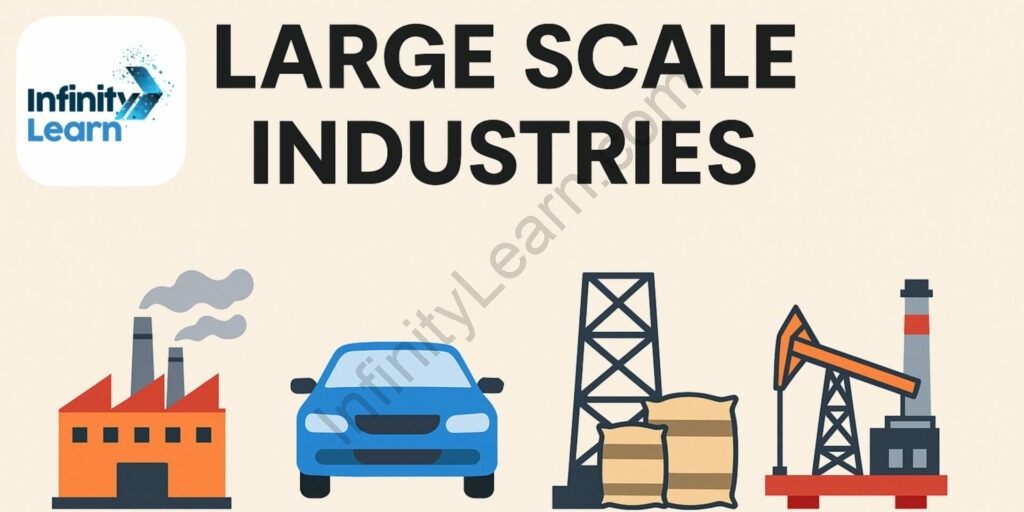Table of Contents
India’s industrial landscape is vast and diverse, with various sectors contributing significantly to the country’s economy. Among these, large-scale industries play a pivotal role, influencing economic growth and social and technological advancement. In this article, we will explore what large-scale industries are, provide examples from India, understand their importance, and look at the various factors that contribute to their growth.
What Are Large-Scale Industries?
Large-scale industries refer to businesses or factories that produce goods on a mass scale, typically requiring significant capital investment, advanced machinery, and a large workforce. These industries are characterized by their ability to produce goods in large quantities, which makes them a key contributor to economic development.

Key Features of Large-Scale Industries:
- High Capital Investment: Large-scale industries require a significant amount of money for machinery, infrastructure, and operations.
- Large Workforce: These industries employ a large number of workers for production and management.
- Advanced Technology: Automation, mechanization, and use of sophisticated machinery are common in large-scale industries.
- Mass Production: These industries often produce goods in large quantities to meet the demands of national or international markets.
Types of Large-Scale Industries
Large-scale industries can be broadly categorized based on their activities and the products they produce. Some of the key types include:
- Manufacturing Industries: These industries focus on the mass production of goods, such as cars, machinery, and electronics.
- Construction Industries: Large-scale construction projects like bridges, roads, and buildings fall under this category.
- Automobile Industry: The automobile industry is one of the largest sectors in India, contributing significantly to both the economy and employment.
- Mining Industries: These industries are involved in the extraction of minerals and other raw materials.
- Textile Industries: Large-scale textile industries manufacture clothing, fabrics, and garments for local and international markets.
- Chemical Industries: These industries are responsible for producing chemicals, fertilizers, and petrochemicals.
Each of these sectors plays an essential role in shaping the economy of the country by providing essential goods and services, creating employment, and driving technological advancements.
Top 10 Large-Scale Industries in India
India boasts a wide variety of large-scale industries that contribute significantly to its economy. Here are the top 10 large-scale industries in India based on their contribution to GDP, employment, and exports:
- Iron and Steel Industry: India is one of the largest producers of steel in the world, with large plants such as Tata Steel and JSW Steel leading the way.
- Automobile Industry: Companies like Tata Motors, Mahindra & Mahindra, and Maruti Suzuki dominate the Indian automotive industry, contributing significantly to the economy.
- Textile Industry: The textile industry in India is one of the oldest and largest in the world, employing millions in manufacturing garments, fabrics, and yarn.
- Petroleum Industry: The petroleum sector, with major players like Indian Oil and Reliance Industries, is a cornerstone of India’s industrial landscape.
- Pharmaceutical Industry: India is a global leader in generic drugs and is home to several major pharmaceutical companies like Sun Pharma and Dr. Reddy’s Laboratories.
- Chemical Industry: The chemical industry in India is vital for producing chemicals, fertilizers, and petrochemicals used in various other industries.
- Cement Industry: India is the second-largest producer of cement globally, with large companies like UltraTech Cement and ACC Ltd.
- Power Generation Industry: Power generation, including renewable sources like solar and wind, forms a major part of India’s energy needs.
- Food Processing Industry: India’s food processing industry produces packaged food, beverages, and dairy products that are both consumed locally and exported.
- Telecommunications Industry: India’s telecom sector, with giants like Airtel and Jio, supports the country’s communication infrastructure.
Investment in Large-Scale Industries
The investment in large-scale industries is often massive, involving the purchase of land, machinery, technology, and infrastructure. The minimum investment needed can vary based on the industry:
- Automobile Manufacturing: Starting a large automobile manufacturing plant requires an investment of hundreds of crores.
- Steel Plants: Large steel manufacturing plants require an investment of up to ₹10,000 crore, depending on the scale.
- Textile Units: A medium to large textile unit may require anywhere between ₹20-50 crore for machinery, infrastructure, and setup costs.
In India, the government has also been facilitating foreign direct investment (FDI) to attract international investors into large-scale industries, offering tax incentives and easier compliance processes.
Examples of Large-Scale Industries in India
Several industries in India qualify as large-scale due to their contribution to the economy and their operational scale. Some examples include:
- Tata Steel: With a production capacity of over 28 million tonnes per year, Tata Steel is one of the largest steel producers in India.
- Maruti Suzuki: India’s leading automobile manufacturer, Maruti Suzuki, has revolutionized the car market with its mass production and large workforce.
- BHEL: Bharat Heavy Electricals Limited (BHEL) is a significant player in the manufacturing of power generation equipment.
- Reliance Industries: A conglomerate involved in petrochemicals, refining, and oil exploration, contributing heavily to India’s GDP.
Small Scale vs Large Scale Industries
While both small-scale and large-scale industries contribute to the economy, the key difference lies in their operational scale, workforce, and capital investment:
- Small-Scale Industries: These are typically characterized by lower investment, limited production capacity, and fewer employees. Examples include small workshops or local food production units.
- Large-Scale Industries: These industries require significant investment, employ a larger workforce, and are involved in mass production. They can impact national or international markets, such as the automobile and textile industries.
Key Factors for the Growth of Large-Scale Industries
The growth of large-scale industries depends on several key factors, including:
- Access to Capital: Adequate investment, both from private and public sectors, is critical for the setup and expansion of large industries.
- Technology: The use of advanced machinery and technology enables large industries to produce goods on a massive scale.
- Labor Force: A skilled labor force is necessary for the smooth functioning of large-scale industries.
- Government Policies: Pro-business policies such as tax incentives, easy access to loans, and infrastructure development help industries grow.
- Infrastructure: Robust infrastructure, including roads, ports, and electricity, is vital for the success of large-scale industries.
Challenges Faced by Large-Scale Industries
Despite their significance, large-scale industries face a range of challenges:
- Environmental Concerns: Pollution and waste management remain significant issues for industries like chemicals and steel manufacturing.
- High Operational Costs: The scale of operations requires continuous investment in machinery, raw materials, and labor.
- Regulatory Hurdles: Large industries often face complex regulations related to environmental standards, labor laws, and trade restrictions.
- Global Competition: As the global market becomes more interconnected, Indian industries must compete with international giants, especially in sectors like automobile manufacturing.
The Future of Large-Scale Industries
The future of large-scale industries in India looks promising, with emerging trends such as:
- Automation and AI: Automation technologies like Artificial Intelligence (AI) and Machine Learning (ML) are set to revolutionize industries by improving production efficiency.
- Sustainability: With growing environmental concerns, large industries are shifting towards sustainable and eco-friendly practices, especially in the manufacturing and energy sectors.
- Global Expansion: As Indian companies continue to grow, they are expanding into global markets, creating new opportunities for growth and innovation.
Advantages of Large Scale Industries
- There are a number of advantages to large-scale industries. Larger industries have more resources and can often produce products more cheaply and efficiently than smaller industries.
- They can also employ more people, which can lead to increased economic activity and job growth in the local community.
- Additionally, large industries can be more environmentally friendly and have stricter safety and quality control measures in place than smaller industries.
- Large scale production reduces the risk. Large scale production helps in reducing the cost and in getting economies of scale. However in large scale production, it is possible to produce more and also more at the same cost.
- Large scale production is more efficient than small scale production. The production output is more and the cost per unit is less.
Large Scale Industries Examples
Some examples of large scale industries are the automobile industry, the steel industry, and also the oil industry.
FAQs on Large Scale Industries
Some of the benefits of large-scale industries include the generation of jobs, the provision of goods and services, and the generation of tax revenue. Additionally, large-scale industries can have a positive effect on a region's economy by attracting other businesses and creating a multiplier effect.
A large scale industry is an industry that employs a significant number of workers and produces a large amount of output.
Some examples of large scale industries are the automobile industry, the steel industry, and also the oil industry.
India's large scale industries includes those industries that contribute to the Indian economic growth. These are Iron and Steel Industry Textile Industry, Automobile Manufacturing Industry, Information and Technology (IT) industry, Telecom Industry. What are some of the benefits of large scale industries?
What is large scale industry?
What are large scale industries examples?
What are India's large scale industries?




